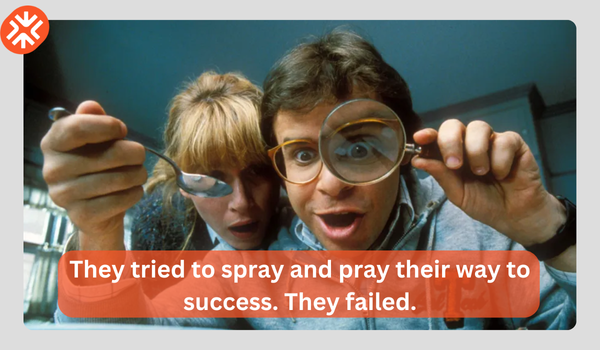What will Logistics Technology look like in 12 months?
Logistics Technology moves fast. Blink and you may miss a change that will have an impact on the entire supply chain. With so much happening right now, what could Logistics Technology look like in 12 months?

As a Logistics Technology nerd, I appreciate the speed at which our industry moves. Things move quickly in the logistics tech space. Blink and a new startup is in your face pushing an aggressive sales and marketing strategy that would annoy even the most patient of forwarders. Take a day off and your favourite SaaS has just been acquired by the newest ocean carrier turned 3PL turned tech company looking to reinvent itself.
So our Logistics Technology space is wild. But does that make it unpredictable? Not really.
As I write the first draft of this publication on March 11 2023, Silicon Valley Bank has been taken over by the powers that be, and we're all waiting with our fingers crossed and our hearts in turmoil to find out who is going to become the first Logtech casualty of this unfortunate turn of events. But in 12 months' time, these events may just be a distant memory. There will be pain, and success stories, but mostly pain, as we take a look at what Logistics Technology will resemble in a year.
Logistics Technology: the potential SVB fallout
In case of emergency break that "single pane of glass" you call a visibility platform and hope for the best.
Prior to the unravelling of Silicon Valley Bank, the Logistics Technology scene was already floundering in the small puddle left after the funding taps were almost closed-off. This situation was of our own creation, and the unhealthy reality that we've crafted could not last. The likes of Flexport and their insane funding rounds (and valuation) increased the attractivity of Logtech. The gold rush during Covid-19, led by ever-increasing rates, combined with the flamboyant personalities of some Logistics Technology founder-CEOs seen at project44 or slync amplified the message.
Before we knew it, the scene was flooded with VC money, SaaS solutions for every non-problem, and a completely distorted vision of reality that would confuse even the most well-informed logistics professional.
Today, that "valley of plenty" is gone, and the pretenders are now being put to the test. Questions are being asked of "buzzword-heavy" solutions such as visibility platforms and "AI-enhanced SaaS solutions", with very few answers on the horizon.
I recently said that today's visibility offering is like trying to sell DVD players to modern-day Netflix subscribers. We're so far behind where BCOs and 3PLs need the technology to be, that the billion dollars sunk into the space by project44 seems like a bad joke. Not to mention the money Fourkites, Shippeo, and other niche players have poured into ocean visibility.
Now multiply the above scenario by each "problem" we've attempted to solve, and you've got a beautifully inflated picture with more solutions than use cases.
The fact that VC funding dried up overnight was bad news for many, but great news for the future of Logistics Technology. Nothing like a health kick "cleanse" after overindulging during the holiday season. But this scenario hasn't had the chance to play out and has now potentially been greatly accelerated by the collapse of SVB.
If the disappearance of a large number of Logtech startups was more or less confirmed by plummeting freight rates, a terrible SPAC IPO by Freightos, and huge haircuts on valuations through M&A activity... We're now potentially witnessing a mass extinction event. This will not be unique to Logistics Technology with startups the world over being impacted. There is still some hope to avoid this if someone swoops in and acquires what's left of SVB within weeks, a highly unlikely yet very welcomed scenario.
So what can we expect things to look like in 12 months in this worst-case scenario?
The likes of Maersk, CMA, MSC, WiseTech Global, Top 3PLs, and anyone else with copious amounts of cash lying around will gorge themselves on readily available tech for sale to the highest bidder, for pennies on the dollar. We will see further consolidation in the Logistics Technology space, which is not necessarily a bad thing, but innovation will take a hit and likely stagnant more than we'd like it to - especially if the likes of WiseTech and Descartes get their hands on highly innovative teams and products.
As for the undesirable solutions that have struggled to find profitability, or simply aren't all that good? I think we already know what the outcomes will be there.
Logistics Technology innovation will lose out to consolidation
Decreasing valuations and a lack of available funding will accelerate future M&A.
The race is on. In fact, the races are on. When you look at Logistics Technology the bloated number of solutions available for each "problem" is worrying. You can even say that the number of problems created by founders imagining problems is just as concerning.
On the freight forwarding side of things, WiseTech Global still have a war chest ready for the right moment, and the right deal. After acquiring Blume Global and Envase, they are still missing a key component of their US Landside strategy: the land transport visibility component. In the same space, Magaya is looking to acquire customs capabilities in Europe, and we can hope that other players such as Softlink and Riege have an M&A strategy ready to go as valuations dip lower.
Why will this stifle innovation? Because it looks like Magaya is playing catch-up with WiseTech, who in turn are not scared of making acquisitions to block potential moves by their competition.
Through the influx of funds over the Covid period, large 3PLs and ocean carriers alike have found themselves with previously unimaginable funds, and a need to spend them. Maersk and CMA are transitioning away from their ocean carrier roots, diversifying their business through heavy M&A. MSC on the other hand is doubling down on its order books, looking to cement its place as the ultimate ocean carrier. Others like Hapag Lloyd are content sitting on the cash and hoping that everything works out. Sure, why not?
What does all this mean for innovation and the future of Logistics Technology?
The potential concentration of brain power, funding, and market share, within the hands of a few stakeholders, will negatively impact the speed at which we innovate. The likes of Maersk Growth or Flexport's own investment arm have their tentacles in many companies, ready to move when they see a threat or an opportunity.
There is another big issue with the concentration of power and knowledge: the ability to make unilateral decisions with a big impact on others. CargoWise is a great example of this. Not only is their approach to price lists a way to keep their 30% compounding growth going, it is also a means to keep competing solutions at bay, and their ecosystem closed.
This brings us to what I believe is one of the best examples of the worst-case scenario for a Logistics Technology company: visibility dashboards. Expedock recently released their own, Prompt have a highly configurable offering, but both these companies have other value propositions. Logixboard on the other hand are the type of Logistics Technology profile that I have high concerns for over the next 12 months.
With a simple visibility dashboard that is more of a sales tool for SMB forwarders to pitch collaboration with BCOs, rather than a tool for actionable data and smart decision-making, Logixboard's offer is light. Regardless of whether Logixboard is impacted by the issues with SVB's uncertainty, the fact that their product and sales & marketing strategy appear built for CargoWise is worrying. With NEO around the corner and CargoWise ready to improve their forwarder to BCO collaboration functionality, Logixboard could be left without a leg to stand on. At such a high valuation and not much to show for it, could the move towards other platforms such as Magaya and Softlink save them? Temporarily, yes. But in the long term? Magaya and Softlink will need their own 3PL to BCO offerings and it is a great area for them to innovate and potentially compete with CargoWise.
In conclusion, it seems like the next 12 months are going to be complicated for Logistics Technology startups. Those who have built their business to be acquired by the highly acquisitive goliaths could be in for bad surprises. They could go on the cheap, or potentially not be acquired at all, with self-developed functionality being released in the future.
Unhealthy startups with no sign of profitability in sight may see their VC backers let them disappear or be acquired for cents on the dollar as the fallout from SVB's collapse takes shape.
Those who are operating healthy and profitable businesses will survive and thrive if they can keep aggressive and highly acquisitive competitors at bay. Refusing a partnership or acquisition by the likes of Maersk or WiseTech Global could see them simply choose someone else, or worse: make it impossible for their customers to work with you.
I'm Anthony, ex-WiseTech'er and Logistics Technology nerd.
You can find me on LinkedIn: https://www.linkedin.com/in/anthonymlr/
And I may start using Twitter if Elon doesn't kill it first: https://twitter.com/Anthonymlr1
My opinions are my own, although I'm sometimes told they are shared by many, yet voiced by few.
My goal is to make Logistics Technology a healthier place and to provide everyone with the kind of information they need to decrypt this magical and mad industry we either love or hate depending on the day and if someone has blocked the Suez Canal again.





